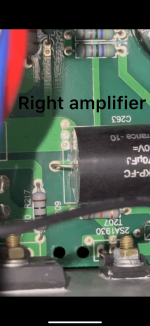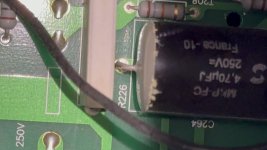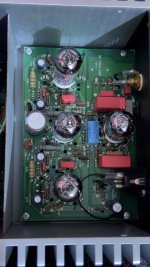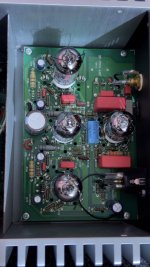jean-paul,
Some inexpensive "isolation transformers" have winding to winding capacitance, so they have more leakage current than the safety regulations allow.
Reminds me of the old radios with no power transformer, un-polarized plug, and RFI capacitor(s) from power lead(s) to the chassis. OUCH!
Some inexpensive "isolation transformers" have winding to winding capacitance, so they have more leakage current than the safety regulations allow.
Reminds me of the old radios with no power transformer, un-polarized plug, and RFI capacitor(s) from power lead(s) to the chassis. OUCH!
It there any soft start component (PTC) prior to the power transformer? It may have failed. It looks like a capacitor mostly green or black in colour.
Attaching 2 images
The capacitor bulging in a suspected amplifier.
The other picture is from the other amplifier which has decent looking capacitors
These are Four Solen Capacitors 4.7uf
Two on each side of the main board
The capacitor bulging in a suspected amplifier.
The other picture is from the other amplifier which has decent looking capacitors
These are Four Solen Capacitors 4.7uf
Two on each side of the main board
Attachments
who should I teII, I have no idea who is the power company that supplies power to him. Maybe Russia? Besides, this is not my quote, you are delusionalNico Ras,
I think if a persons AC Power Mains has DC on it, the Power Mains Company wants to know that (So tell them).
Put the burden of fixing that on the Power Mains Company.
That is like the gas station that has water in their gas, do you want to fix it yourself?
Last edited:
Check these with an ESR meter and lift one terminal from the PCB and measure capacitance. These could be defective or not!
These are not electrolitic capacitors!
In my view, the cause of DC at the output is most often semiconductor related.
I would need more info to get deeper in the problem.
Does the speaker protection relay engages some seconds after power on?
Are any fuses blown?
These are not electrolitic capacitors!
In my view, the cause of DC at the output is most often semiconductor related.
I would need more info to get deeper in the problem.
Does the speaker protection relay engages some seconds after power on?
Are any fuses blown?
Well guys.....
Forget about the AC power.
As mentioned in the first post, this amp has a double triode at the input. If I remember correctly, it´s a 12AU7, a 6922 and a pair of 6CG7/6N6P.
The rest of the amp is dc-coupled, so my 5 cents would be to look at tube output, guessing through the 4,7µF Solen´s.
This slow "motorboating" could be a defective tube or some components around it. Also check the tube anode supply, which would
be in the order of somewhere between 150 & 300 volt, and make sure this is absolutely stable.
DC on mains will cause the transformer to hum mechanically. Nothing else inside the amp.
Forget about the AC power.
As mentioned in the first post, this amp has a double triode at the input. If I remember correctly, it´s a 12AU7, a 6922 and a pair of 6CG7/6N6P.
The rest of the amp is dc-coupled, so my 5 cents would be to look at tube output, guessing through the 4,7µF Solen´s.
This slow "motorboating" could be a defective tube or some components around it. Also check the tube anode supply, which would
be in the order of somewhere between 150 & 300 volt, and make sure this is absolutely stable.
DC on mains will cause the transformer to hum mechanically. Nothing else inside the amp.
Last edited:
The capacitor bulging in a suspected amplifier.
The other picture is from the other amplifier which has decent looking capacitors
These are Four Solen Capacitors 4.7uf
Two on each side of the main board
Film capacitors like those don't leak. Look elsewhere for the problem.
@Boydk
Just tried something while troubleshooting the Amplifier...
There is a selection switch behind input section to select between RCA or XLR
When i move the switch to XLR, behavior normalized
Looks like something not working right in RCA input circuit.
1. No Input Connected
2. Only Speaker A terminal connectors to LF terminals of the speakers
Just tried something while troubleshooting the Amplifier...
There is a selection switch behind input section to select between RCA or XLR
When i move the switch to XLR, behavior normalized
Looks like something not working right in RCA input circuit.
1. No Input Connected
2. Only Speaker A terminal connectors to LF terminals of the speakers
Attachments
Last edited:
Looks like you´ve located the culprit then.@Boydk
Just tried something while troubleshooting the Amplifier...
There is a selection switch behind input section to select between RCA or XLR
When i move the switch to XLR, behavior normalized
Looks like something not working right in RCA input circuit.
Make sure, it´s not a bad connection in the SE/BAL-switch itself.
Now would be the time to get a schematic.
The company to ask is "Sintron Distribution GmbH".
Contact info in bottom of LINK
Why buy inexpensive stuff when it does not fulfill the requirements? Can such stuff even be bought in developed countries? Safety stuff that is unsafe. One then better uses the oscilloscope directly on mains circuits 😉jean-paul,
Some inexpensive "isolation transformers" have winding to winding capacitance, so they have more leakage current than the safety regulations allow.
Reminds me of the old radios with no power transformer, un-polarized plug, and RFI capacitor(s) from power lead(s) to the chassis. OUCH!
The comparison is with old radios is off. These could have L on the chassis.
Niko Ras,
You said: "Make a DC blocker into your power amps and see if it solves your problem"
I answered not for you.
I answered for the original poster who has the problem . . .
He should contact His Power Company.
As I said, do not take bad gasoline that has water in it and try do-it-yourself removal of the water . . .
All the water will come out when you accidentally ignite the gasoline!
I may be delusional, but at least I did not start any fires.
You said: "Make a DC blocker into your power amps and see if it solves your problem"
I answered not for you.
I answered for the original poster who has the problem . . .
He should contact His Power Company.
As I said, do not take bad gasoline that has water in it and try do-it-yourself removal of the water . . .
All the water will come out when you accidentally ignite the gasoline!
I may be delusional, but at least I did not start any fires.
As I have often said, "Know Thy Power Mains".
Everything about them.
Then, work for 2 years on a US Naval Destroyer, work on the communication equipment, and on the power mains.
Survive all those dangers.
Then spend the rest of your life as a measurements expert, and as a safety expert, etc.
Help out UL laboratories Newbies. (Yes, Underwriters Laboratories).
Some UL Newbies were floating their oscilloscope, in order to make Pseudo Differential Measurements. OUCH!
If anybody does not understand their power mains, and does not understand their measurement equipment, then they need to keep their hands off.
If anybody does not understand their tube amplifiers, and does not understand their measurement equipment, then they need to keep their hands off.
They will need an experienced expert to show them how to do the measurements.
Safety First!
Prevent the "Surviving Spouse Syndrome". Otherwise your friend may be consoling your spouse in ways generally unacceptable to you.
There is a Thread on Safety on diyAudio.
Read some or all of it.
When it comes to purchasing isolation transformers . . . Caveat Emptor (Buyer Beware).
When it comes to using Quality isolation transformers . . . User Beware, you still can get nailed (or get nails put in your coffin).
Yes, I have used isolation transformers.
Everything about them.
Then, work for 2 years on a US Naval Destroyer, work on the communication equipment, and on the power mains.
Survive all those dangers.
Then spend the rest of your life as a measurements expert, and as a safety expert, etc.
Help out UL laboratories Newbies. (Yes, Underwriters Laboratories).
Some UL Newbies were floating their oscilloscope, in order to make Pseudo Differential Measurements. OUCH!
If anybody does not understand their power mains, and does not understand their measurement equipment, then they need to keep their hands off.
If anybody does not understand their tube amplifiers, and does not understand their measurement equipment, then they need to keep their hands off.
They will need an experienced expert to show them how to do the measurements.
Safety First!
Prevent the "Surviving Spouse Syndrome". Otherwise your friend may be consoling your spouse in ways generally unacceptable to you.
There is a Thread on Safety on diyAudio.
Read some or all of it.
When it comes to purchasing isolation transformers . . . Caveat Emptor (Buyer Beware).
When it comes to using Quality isolation transformers . . . User Beware, you still can get nailed (or get nails put in your coffin).
Yes, I have used isolation transformers.
Last edited:
Yes naval destroyers are there to prevent the surviving spouse syndrome 😀
Tip: medical isolation transformers are very expensive due to the very low leakage but less so bought surplus. Of course preferably unused/new in box. Mine are found like this, shiny German medical quality new in box with certificates. When you are done measuring they are a very useful tool in an audio chain too.
Tip: medical isolation transformers are very expensive due to the very low leakage but less so bought surplus. Of course preferably unused/new in box. Mine are found like this, shiny German medical quality new in box with certificates. When you are done measuring they are a very useful tool in an audio chain too.
Last edited:
Coincidentally I just bought a new medical one. 300VA, 4 outputs. Has a pro mains filter, power on/off switch, green power on LED and should be silent. Separate PE clamp as usual with medical stuff.
Last edited:
Looks like you´ve located the culprit then.
Make sure, it´s not a bad connection in the SE/BAL-switch itself.
Now would be the time to get a schematic.
The company to ask is "Sintron Distribution GmbH".
Contact info in bottom of LINK
Attachments
Correct. No removal or separation required. Simply add alcohol and let the magic begin.As I said, do not take bad gasoline that has water in it and try do-it-yourself removal of the water
Last edited:
@968driver
Amplifier is packed like a tank,looks like it is impossible to access under the input tube section for measurements unless getting the whole thing apart.
Very frustrating!
I will try swapping the tubes from my second identical amplifier and see if it solves the issue.
Regards
Amplifier is packed like a tank,looks like it is impossible to access under the input tube section for measurements unless getting the whole thing apart.
Very frustrating!
I will try swapping the tubes from my second identical amplifier and see if it solves the issue.
Regards
You can measure at the terminals of the two big black capacitirs near the RCA connector input tube V101.
You should see an audio signal at these 4 points.
You should see an audio signal at these 4 points.
Connect to a preamplifier for an input signal on the RCA inputs.
Monitor the anode and cathode of V101a for an output signal.
Same for the XLR / RCA input switch.
V101, coupling caps or switch could be suspects.
Attachments
- Home
- Amplifiers
- Tubes / Valves
- Vincent SP-T800 Power Amplifier DC Volts on Speaker Output Terminals



